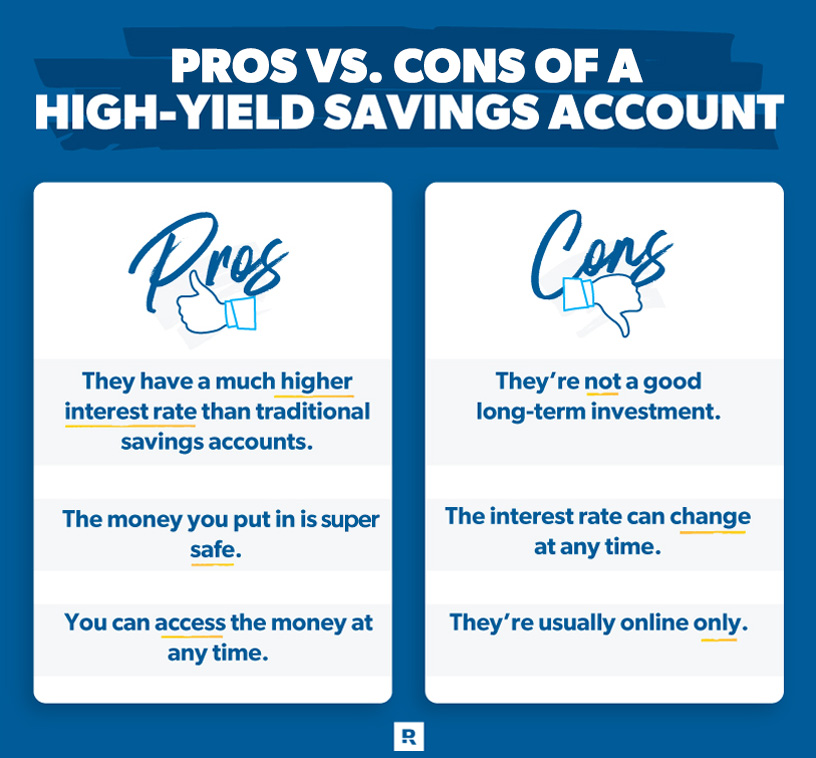Definition of High-Yield Savings Accounts

High-yield savings accounts are specialized accounts offered by financial institutions that typically offer higher interest rates compared to traditional savings accounts. These accounts are designed to help individuals grow their savings faster by earning more interest on their deposits.
Differences from Regular Savings Accounts
- Higher Interest Rates: High-yield savings accounts offer significantly higher interest rates, allowing account holders to earn more on their savings over time.
- Minimum Balance Requirements: Some high-yield savings accounts may require a higher minimum balance to earn the advertised interest rate.
- Limited Transactions: Unlike regular savings accounts, high-yield savings accounts may have restrictions on the number of withdrawals allowed per month.
Financial Institutions Offering High-Yield Savings Accounts
- Ally Bank: Ally Bank is known for its competitive high-yield savings account rates and no monthly maintenance fees.
- Citibank: Citibank offers a high-yield savings account with competitive interest rates and easy online account management.
- Discover Bank: Discover Bank provides a high-yield savings account with no minimum balance requirements and 24/7 customer support.
Benefits of High-Yield Savings Accounts
- Higher Returns: With the higher interest rates offered, individuals can maximize their savings and earn more over time.
- Security: High-yield savings accounts are typically FDIC-insured up to the maximum limit, providing a secure way to grow savings.
- Liquidity: While offering higher interest rates, high-yield savings accounts still allow easy access to funds when needed, providing a balance between growth and accessibility.
Features of High-Yield Savings Accounts

High-yield savings accounts offer a range of features that make them an attractive option for individuals looking to grow their savings. Let’s delve into the specifics of these accounts.
Interest Rates
High-yield savings accounts typically offer interest rates that are significantly higher than traditional savings accounts. While rates can vary depending on the financial institution and prevailing market conditions, these accounts generally provide a higher return on your savings.
Minimum Balance Requirements and Fees
Many high-yield savings accounts do not have strict minimum balance requirements, making them accessible to a wide range of savers. Additionally, these accounts often have little to no fees associated with them, making them a cost-effective way to save and earn interest.
Accessibility and Liquidity
High-yield savings accounts offer easy access to your funds, allowing you to withdraw money as needed without facing penalties or restrictions. This makes them a more liquid option compared to certain long-term investment vehicles like certificates of deposit (CDs) or bonds. While they may not offer the same potential for high returns as riskier investments, high-yield savings accounts provide a balance of accessibility and interest-earning potential that appeals to many savers.
Opening and Managing a High-Yield Savings Account
Opening a high-yield savings account is a straightforward process that typically involves a few key steps. Once the account is open, managing it effectively can help you maximize the benefits it offers.
Steps to Open a High-Yield Savings Account
- Research: Compare different financial institutions offering high-yield savings accounts to find one that suits your needs.
- Choose an Account: Select the high-yield savings account that offers the best interest rates and features.
- Provide Information: Fill out the necessary forms and provide identification to open the account.
- Make an Initial Deposit: Some high-yield savings accounts may require a minimum initial deposit to open the account.
- Review Terms and Conditions: Familiarize yourself with the account terms, including fees, withdrawal limits, and any other important details.
Depositing and Withdrawing Funds
- Deposits: You can deposit funds into your high-yield savings account through various methods, such as direct deposit, online transfers, or in-person deposits at a branch.
- Withdrawals: Withdraw funds from your account by transferring money to another account, using an ATM, or visiting a branch to make a withdrawal.
- Online Access: Many high-yield savings accounts offer online access, making it convenient to manage your funds from anywhere.
Maximizing Benefits of a High-Yield Savings Account
- Regular Contributions: Make regular contributions to your account to maximize interest earnings over time.
- Avoid Fees: Be mindful of any fees associated with the account and try to minimize them to maximize your savings.
- Monitor Interest Rates: Keep an eye on interest rate changes and consider moving funds to accounts with higher rates for better returns.
- Set Savings Goals: Establish savings goals to stay motivated and track your progress as you grow your savings in a high-yield account.
Safety and Security of High-Yield Savings Accounts

High-yield savings accounts are known for offering competitive interest rates, but it’s essential to understand the safety and security measures in place to protect your funds.
Measures taken by financial institutions
Financial institutions that offer high-yield savings accounts typically ensure the safety of your funds through:
- FDIC or NCUA insurance: Most high-yield savings accounts are insured by the Federal Deposit Insurance Corporation (FDIC) or the National Credit Union Administration (NCUA), providing coverage up to a certain limit per depositor, per institution.
- Encryption and security protocols: Banks and credit unions use encryption and secure login processes to protect your account information from unauthorized access.
- Fraud monitoring: Financial institutions have fraud detection systems in place to monitor account activity and alert you to any suspicious transactions.
Comparison with other investment vehicles
High-yield savings accounts are considered safer than many other investment vehicles due to the following reasons:
- Stability: Unlike stocks or mutual funds, the funds in a high-yield savings account are not subject to market fluctuations, making them a more stable option.
- FDIC or NCUA insurance: The insurance coverage provided by these agencies adds an extra layer of protection that is not available with riskier investments.
- Liquidity: High-yield savings accounts offer easy access to your funds without penalties or restrictions, unlike some long-term investments.
Tips for maintaining security
Here are some tips to help you maintain the security of your high-yield savings account:
- Use strong, unique passwords for your account and enable two-factor authentication if available.
- Avoid sharing sensitive account information or login credentials with anyone.
- Regularly monitor your account activity and report any suspicious transactions to your financial institution immediately.
- Keep your contact information up to date with the bank or credit union to ensure you receive important account notifications.